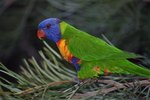Native to Australia, Indonesia and Papua New Guinea, sugar gliders live in treetops and feed at night. They're very sociable, preferring to live in communal nests that house 5 to 7 adults. Sugar gliders have unique requirements, and in captivity, they can suffer if they're improperly housed, poorly fed or kept alone. With proper care and nutrition, though, they can survive for more than a decade.
Breeding and Birth
Female sugar gliders can breed when they’re 7 to 10 months old. Males reach sexual maturity a little later, when they’re just over a year. After a gestation period of around 16 days, the female gives birth to one or two joeys, who each weigh around 7 thousandths (.007) of an ounce. In their natural environment, almost every female has at least one litter, and sometimes more, annually.
Pouch
Like other marsupials, such as kangaroos and koalas, female sugar gliders carry their newborns in pouches. Young joeys nurse, grow and develop in their mother’s pouch for 70 to 90 days. After they emerge, they spend several months transitioning from their mother’s milk to solid foods. By the time they’re around 4 months old, they can survive independently. By the time they reach adulthood, sugar gliders weigh around 4 pounds.
Diet
In their natural environment, omnivorous sugar gliders eat an array of food. Their prey includes beetles, moths, other insects and spiders. They also eat acacia gum, honeydew, nectar, pollen and sap from eucalyptus trees. As their name indicates, sugar gliders love sweets, and especially in captivity, they can become obese. If you have pet sugar gliders, ask a qualified exotic-animal vet to help you establish a healthy diet.
Health
Captive animals often suffer from stress, improper care and preventable diseases. Take your sugar glider to a qualified vet at least once a year for a checkup, including a fecal exam to look for parasites. Because you might not see obvious symptoms until your pet is extremely ill, be alert to any symptoms, such as pain, lack of appetite, change in routine or watery excrement. Consult your vet immediately if you notice any behaviors that might indicate injury or disease. With proper care, housing and food, sugar gliders can live up to 14 or 15 years.
References
Resources





